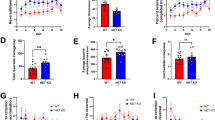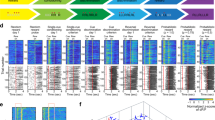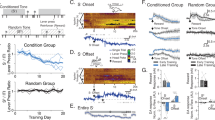Abstract
Dopamine has been critically implicated in learning and motivation, although its precise role remains to be determined. In order to investigate the involvement of dopamine in learning and motivation for a food reward, we used dopamine transporter knockdown mice (DAT KD) that have chronically elevated levels of extracellular dopamine. The present study demonstrates that chronically elevated dopamine enhances tendency to work for a food reward without apparent effects on Pavlovian and operant learning for this reward. The increase in dopamine is associated with elevated levels of dynorphin and Fos B expression in the dorsal caudate-putamen and the core but not the shell subregion of the nucleus accumbens. These data suggest that motivation to work, but not learning, for a food reward appears to be under the critical influence of tonic dopaminergic activity in discrete brain areas relevant for a reward-directed behavior.
Similar content being viewed by others
Log in or create a free account to read this content
Gain free access to this article, as well as selected content from this journal and more on nature.com
or
References
Aberman JE, Salamone JD (1999). Nucleus accumbens dopamine depletions make rats more sensitive to high ratio requirements but do not impair primary food reinforcement. Neuroscience 92: 545–552.
Aberman JE, Ward SJ, Salamone JD (1998). Effects of dopamine antagonists and accumbens dopamine depletions on time-constrained progressive ratio performance. Pharmacol Biochem Behav 61: 341–348.
Beninger RJ, Miller R (1998). Dopamine D1-like receptors and reward-related incentive learning. Neurosci Biobehav Rev 22: 335–345.
Cadoni C, Solinas M, Valentini V, Di Chiara G (2003). Selective psychostimulant sensitization by food restriction: differential changes in accumbens shell and core dopamine. Eur J Neurosci 18: 2326–2334.
Calabresi P, Maj R, Pisani A, Mercuri NB, Bernardi G (1992). Long-term synaptic depression in the striatum: physiological and pharmacological characterization. J Neurosci 12: 4224–4233.
Carboni E, Tanda GL, Frau R, Di Chiara G (1990). Blockade of the noradrenaline carrier increases extracellular dopamine concentrations in the prefrontal cortex: evidence that dopamine is taken up in vivo by noradrenergic terminals. J Neurochem 55: 1067–1070.
Cardinal RN, Parkinson JA, Hall J, Everitt BJ (2002). Emotion and motivation: the role of amygdala, ventral striatum, and prefrontal cortex. Neurosci Biobehav Rev 26: 321–352.
Carr KD (2002). Augmentation of drugs reward by chronic food restriction: behavioral evidence and underlying mechanisms. Physiol Behav 76: 353–364.
Carr KD, Tsimberg Y, Berman Y, Yamamoto N (2003). Evidence of increased dopamine receptor signaling in food-restricted rats. Neuroscience 119: 1157–1167.
Centonze D, Picconi B, Gubellini P, Bernardi G, Calabresi P (2001). Dopaminergic control of synaptic plasticity in the dorsal striatum. Eur J Neurosci 13: 1071–1077.
Cole RL, Konradi C, Douglass J, Hyman SE (1995). Neuronal adaptation to amphetamine and dopamine: molecular mechanisms of prodynorphin gene regulation in rat striatum. Neuron 14: 813–823.
Corbit LH, Muir JL, Balleine BW (2001). The role of the nucleus accumbens in instrumental conditioning: evidence of a functional dissociation between accumbens core and shell. J Neurosci 21: 3251–3260.
Cousins MS, Salamone JD (1994). Nucleus accumbens dopamine depletions in rats affect relative response allocation in a novel cost/benefit procedure. Pharmacol Biochem Behav 49: 86–91.
Cousins MS, Sokolowski JD, Salamone JD (1993). Different effects of nucleus accumbens and ventrolateral striatal dopamine depletions on instrumental response selection in rats. Pharmacol Biochem Behav 46: 943–951.
Cousins MS, Atherton A, Turner L, Salamone JD (1996). Nucleus accumbens dopamine depletions alter relative response allocation in a T-maze cost-benefit task. Behav Brain Res 74: 189–197.
Di Chiara G (2002). Nucleus accumbens shell and core dopamine: differential role in behavior and addiction. Behav Brain Res 137: 75–114.
Di Chiara G, Basareo V, Fenu S, De Luca MA, Spina L, Cadoni C et al (2004). Dopamine and drugs addiction: the nucleus accumbens shell connection. Neuropharmacology 47: 227–241.
Di Ciano P, Cardinal RN, Cowell RA, Little SJ, Everitt BJ (2001). Differential involvement of NMDA, AMPA/Kainate, and dopamine receptors in the nucleus accumbens core in the acquisition and performance of Pavlovian approach behavior. J Neurosci 21: 9471–9477.
Duarte C, Lefebre C, Chaperon F, Hamon M, Thiebot MH (2003). Effects of a dopamine D3 receptor ligand BP897 on acquisition and expression of food-, morphine-, and cocaine-induced conditioned place preference, and food-seeking behavior in rats. Neuropsychopharmacology 28: 1903–1915.
Eagle DM, Humby T, Dunnett SD, Robbins TW (1999). Effects of regional striatal lesions on motor, motivational, and executive aspects of progressive-ratio performance in rats. Behav Neurosci 113: 718–731.
Everitt BJ, Dickinson AD, Robbins TW (2001). The neuropsychological basis of addictive behaviour. Brain Res Rev 36: 129–138.
Gallistel CR, Fairhust S, Balsam PD (2004). The learning curve: Implication of a quantitative analysis. Proc Natl Acad Sci USA 101: 13124–13131.
Gerfen CR (1992). The neostriatal mosaic: multiple levels of compartmental organization. Trends Neurosci 15: 133–139.
Graybiel AM (1995). The basal ganglia. Trends Neurosci 18: 60–62.
Hamill S, Trevitt JT, Nowend KL, Carlson BB, Salamone JD (1999). Nucleus accumbens dopamine depletions and time-constrained progressive ratio performance: effects of different ratio requirements. Pharmacol Biochem Behav 64: 21–27.
Hanlon EC, Baldo BA, Sadeghian K, Kelley AE (2004). Increases in food intake of food-seeking behavior induced by GABAergic, opioid, or dopaminergic stimulation of the nucleus accumbens: is it hunger? Psychopharmacology 172: 241–247.
Hironaka N, Ikeda K, Sora I, Uhl GR, Niki H (2004). Food-reinforced operant behavior in dopamine transporter knockout mice. Ann NY Acad Sci USA 1025: 140–145.
Hodos W (1961). Progressive ratio as a measure of reward strength. Science 134: 943–944.
Hoffman DC, Beninger RJ (1989). The effects of selective dopamine D1 and D2 receptor antagonists on the establishment of agonist-induced place conditioning in rats. Pharmacol Biochem Behav 33: 273–279.
Ikemoto S, Panksepp J (1996). Dissociations between appetitive and consummatory responses by pharmacological manipulations of reward-relevant brain regions. Behav Neurosci 110: 331–345.
Ito R, Robbins TW, Everitt BJ (2004). Differential control over cocaine-seeking behavior by nucleus accumbens core and shell. Nat Neurosci 7: 389–397.
Kiyatkin EA (1995). Functional significance of mesolimbic dopamine. Neurosci Biobehav Rev 19: 573–598.
Koch M, Schmid A, Schnitzler HU (2000). Role of nucleus accumbens dopamine D1 and D2 receptors in instrumental and Pavlovian paradigms of conditioned reward. Psychopharmacology 152: 67–73.
McCullough LD, Cousins MS, Salamone JD (1993). The role of nucleus accumbens dopamine in responding on a continuous reinforcement operant schedule: a neurochemical and behavioral study. Pharmacol Biochem Behav 46: 581–586.
Moron JA, Brockington A, Wise RA, Rocha BA, Hope BT (2002). Dopamine uptake through the norepinephrine transporter in brains regions with low levels of dopamine transporter: evidence from knock-out mice lines. J Neurosci 22: 389–395.
Nakajima S (1989). Subtypes of dopamine receptors involved in the mechanism of reinforcement. Neurosci Biobehav Rev 13: 123–128.
Nestler EJ (2004). Molecular mechanisms of drug addiction. Neuropharmacology 47: 24–32.
Nestler ER, Kelz MB, Chen J (1999). DeltaFosB: a molecular mediator of long-term neural and behavioral plasticity. Brain Res 835: 10–17.
Nowend KL, Arizzi M, Carlson BB, Salamone JD (2001). D1 and D2 antagonism in the nucleus accumbens core or dorsomedial shell suppresses lever pressing for food but leads to compensatory increases in chow consumption. Pharmacol Biochem Behav 69: 373–382.
Nye HE, Hope BT, Kelz MB, Iadarola M, Nestler EJ (1995). Pharmacological studies of the regulation of chronic FOS-related antigen induction by cocaine in the striatum and nucleus accumbens. J Pharmacol Exp Ther 275: 1671–1680.
Parkinson JA, Dalley JW, Cardinal RN, Bamford A, Fehnert B, Lachenal G et al (2002). Nucleus accumbens dopamine depletion impairs both acquisition and performance of appetitive Pavlovian approach behaviour: implications for mesoaccumbens dopamine function. Behav Brain Res 137: 149–163.
Pecina S, Cagniard B, Berridge KC, Aldridge JW, Zhuang X (2003). Hyperdopaminergic mutant mice have higher ‘wanting’ but not ‘liking’ for a sweet rewards. J Neurosci 23: 9395–9402.
Poncelet M, Chermat R, Soubrie P, Simon P (1983). The progressive ratio schedule as a model for studying the psychomotor stimulant activity of drugs in the rat. Psychopharmacology 80: 184–189.
Robinson S, Sandstrom SM, Denenberg VH, Palmiter RD (2005). Distinguishing whether dopamine regulates liking, wanting, and/or learning about rewards. Behav Neurosci 119: 5–15.
Roitman MF, Stuber GD, Phillips PE, Wightman PE, Carelli RM (2004). Dopamine operates as a subsecond modulator of food seeking. J Neurosci 24: 1265–1271.
Salamone JD, Correa M (2002). Motivational views of reinforcement: implications for understanding the behavioral functions of nucleus accumbens dopamine. Behav Brain Res 137: 3–25.
Salamone JD, Cousins MS, Bucher S (1994). Anhedonia or anergia? Effects of haloperidol and nucleus accumbens dopamine depletion on instrumental response selection in a T-maze cost/benefit procedure. Behav Brain Res 65: 221–229.
Schultz W (2002). Getting formal with dopamine and reward. Neuron 36: 241–263.
Schultz W, Dayan P, Montague PR (1997). A neural substrate of prediction and reward. Science 275: 1593–1599.
Smith-Roe SL, Kelley AE (2000). Coincident activation of NMDA and dopamine D1 receptors within the nucleus accumbens core is required for appetitive instrumental learning. J Neurosci 20: 7737–7742.
Spyraki C, Fibiger HC, Phillips AG (1982). Attenuation by haloperidol of place preference conditioning using food reinforcement. Psychopharmacology 77: 379–382.
Wise RA (2004). Dopamine, learning and motivation. Nat Rev 5: 1–12.
Wise RA, Schwartz HV (1981). Pimozide attenuates acquisition of lever pressing for food in rats. Pharmacol Biochem Behav 15: 655–656.
Yamamoto BK, Novotney S (1998). Regulation of extracellular dopamine by the norepinephrine transporter. J Neurochem 71: 274–280.
Zhang M, Balmadrid C, Kelley AE (2003). Nucleus accumbens opioid, GABAergic, and dopaminergic manipulation of palatable food motivation: contrasting effects revealed by a progressive ratio study in the rat. Behav Neurosci 117: 202–211.
Zhou Q-Y, Palmiter RD (1995). Dopamine-deficient mice are severely hypoactive, adipsic, and aphagic. Cell 83: 1197–1209.
Zhuang X, Oosting RS, Jones SR, Gainetdinov RR, Miller GW, Caron MG et al (2001). Hyperactivity and impaired response habituation in hyperdopaminergic mice. Proc Natl Acad Sci USA 98: 1982–1987.
Acknowledgements
This work was supported by NIMH Grant MH66216 to XZ, Tourette Syndrome Association Fellowship to BC, NIMH Grant MH068073 to PB and NIDA Grant DA015210 to PB. We thank Dr Kent Berridge for helpful suggestions throughout the experiments and Dr Nobuyoshi Suto for critical reading of the manuscript. Jessica Klein, Lindsay Miller, Diana Park, Mary Shaw and Ali Hussain helped with various aspects of the experiments.
Author information
Authors and Affiliations
Corresponding author
Rights and permissions
About this article
Cite this article
Cagniard, B., Balsam, P., Brunner, D. et al. Mice with Chronically Elevated Dopamine Exhibit Enhanced Motivation, but not Learning, for a Food Reward. Neuropsychopharmacol 31, 1362–1370 (2006). https://doi.org/10.1038/sj.npp.1300966
Received:
Revised:
Accepted:
Published:
Issue date:
DOI: https://doi.org/10.1038/sj.npp.1300966
Keywords
This article is cited by
-
Distinct roles for dopamine clearance mechanisms in regulating behavioral flexibility
Molecular Psychiatry (2021)
-
Dose-response effects of d-amphetamine on effort-based decision-making and reinforcement learning
Neuropsychopharmacology (2021)
-
Differentiating effort-related aspects of motivation from reinforcement learning: commentary on Soder et al. “Dose–response effects of d-amphetamine on effort-based decision-making and reinforcement learning”
Neuropsychopharmacology (2021)
-
Energizing effects of bupropion on effortful behaviors in mice under positive and negative test conditions: modulation of DARPP-32 phosphorylation patterns
Psychopharmacology (2021)
-
Behavioral and dopamine transporter binding properties of the modafinil analog (S, S)-CE-158: reversal of the motivational effects of tetrabenazine and enhancement of progressive ratio responding
Psychopharmacology (2020)



